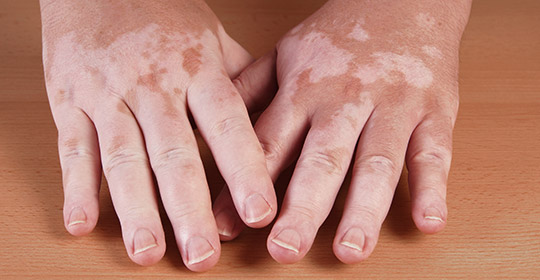What is vitiligo?
What is vitiligo?
Vitiligo is a very distinctive skin disorder involving the loss of skin colour in patches, which can be localized to a particular area of the body or generalized over large portions of it.

Causes
The disease occurs when the melanocytes – pigment-producing cells that give skin its colour – are destroyed. As a result, discoloured patches of skin of varying sizes develop, covering only one part of the body (segmental vitiligo) or many parts (generalized vitiligo).
No one knows exactly what causes vitiligo. People with a family history of the disease or those with an autoimmune disorder (e.g. thyroid gland problem, Addison’s disease, pernicious anemia) are at a higher risk for it.
Triggers
Certain factors can trigger vitiligo:
- Sun exposure
- Sunburns
- Contact with certain chemicals, such as phenols (used in photography and hair colouring)
- Intense stress or emotional shock
Diagnosis and treatments
Vitiligo affects only 1 to 2 percent of the population and usually develops between the ages of 10 and 30. It is typically diagnosed by a physical examination of the skin. Use of an ultraviolet light can help to determine the extent of the areas affected. Blood tests are also done to screen for any underlying autoimmune disease. Biopsies are rarely required.
There is no cure for vitiligo. Existing treatments have different goals, including to:
- Limit the number and size of discoloured skin patches
- Restore pigmentation by stimulating the growth of melanocytes
- Remove the remaining pigment from the rest of the skin when vitiligo is widespread
To better understand the treatments available, it is best to speak with a doctor or dermatologist.
Implications and consequences
The only symptom of vitiligo is the appearance of white patches on the body. It is not contagious, nor is it physically painful for those affected.
However, given that the melanocytes have been destroyed, they are no longer able to fulfil their protective barrier role, making depigmented skin more sensitive to the sun. This means a higher risk for sunburns and skin cancer. Sun safety is especially important for people with vitiligo. This includes always wearing sunscreen with an FPS of at least 30 and following the basic rules on sun protection whenever you spend time outdoors.
Sadly, because vitiligo affects a person’s appearance, it often leads to lower self-esteem and psychological distress. Psychological support can be helpful in such cases.
Corrective cosmetics
For those days when you do not feel up to dealing with people’s stares and comments, you always have the option of camouflaging the patches. There is a full lineup of corrective dermo-cosmetic products available in stores. They are specially made to hide various types of skin problems, such as acne, rosacea, pigment spots (age spots), scars, angioma and vitiligo.
Self-tanners can also be used to help reduce the look of discolouration.
Pharmacy services
Do you have questions about vitiligo and its treatments? Talk to your family pharmacist for answers. And if you need information on corrective makeup, just ask your dermo-cosmetic consultant for help.
The pharmacy services presented in this section are offered by pharmacist owners who are affiliated with Uniprix. The pharmacists are solely responsible for the professional activities carried out during the practice of pharmacy. These services are offered in participating pharmacies only. Certain fees and conditions may apply.
* The information contained herein is provided for informational purposes only and is not intended to provide complete information on the subject matter or to replace the advice of a health professional. This information does not constitute medical consultation, diagnosis or opinion and should not be interpreted as such. Please consult your health care provider if you have any questions about your health, medications or treatment.
